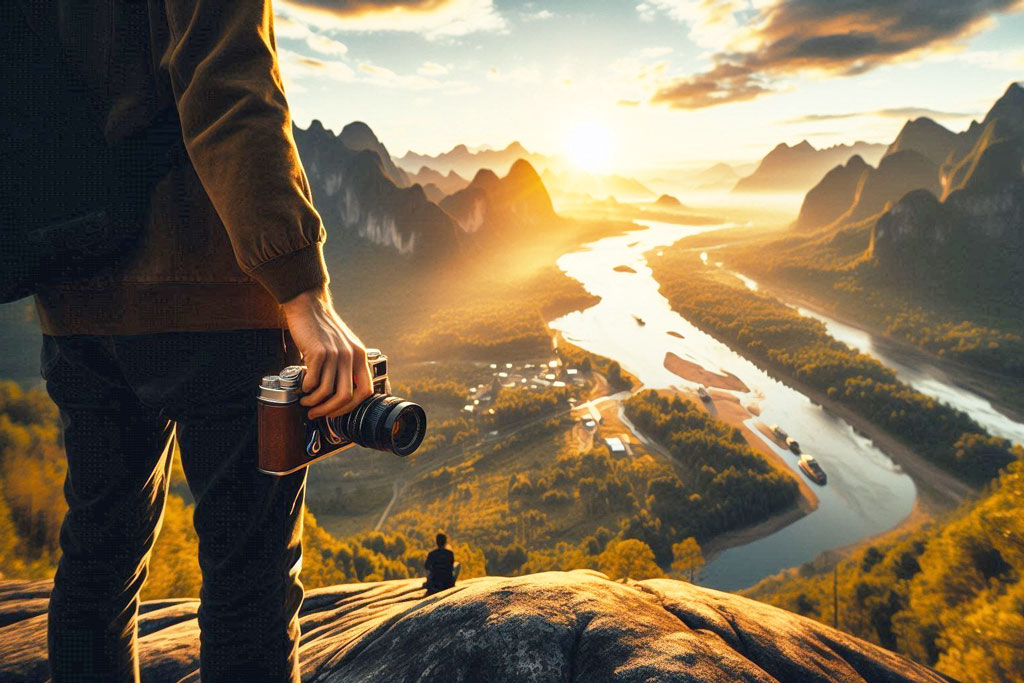When it comes to photography, capturing an image is much more than just pointing your camera and clicking the shutter. The true art lies in the decisions you make before the shot is taken, and one of the most crucial decisions is choosing your vantage point. A photographer’s vantage point is everything—it’s the perspective from which you shoot, and it can completely transform a photo. Whether you’re a seasoned professional or just starting out, understanding and mastering the concept of vantage point can elevate your photography to new heights.
Table of Contents
What is a Vantage Point in Photography?
Simply put, a vantage point in photography is the position from which you take a photograph. This could be from the ground, looking up at a subject, or from high above, looking down. It might be from inside a car, perched on a hill, or standing at eye level. The vantage point you choose is critical because it determines how your subject is framed, how the light interacts with it, and what story your photo ultimately tells.
Every time you lift your camera, you’re making a choice about where to stand and how to frame your shot. These choices might seem small, but they can make or break a photograph. Get it wrong, and your photo might end up looking flat or uninteresting. But get it right, and you can capture stunning images that express your unique vision and creativity.
Why Vantage Point Matters
Your vantage point does more than just change the angle of your shot; it affects the entire composition, mood, and narrative of your photograph. It’s easy to get caught up in the technical aspects of photography—things like exposure, focus, and lighting—but the vantage point is equally important. The perspective you choose can add layers of meaning to your image or bring out elements that would otherwise go unnoticed.
For instance, shooting from a high vantage point can create a sense of distance or detachment, emphasizing the scale of a landscape or the smallness of a subject. On the other hand, a low vantage point can make a subject appear larger-than-life, adding drama and intensity to the scene. Meanwhile, shooting at eye level often feels more intimate and direct, providing a sense of honesty in the image.
Photography is all about showing the world from your point of view. By experimenting with different vantage points, you can highlight details, create new perspectives, and tell stories that resonate with viewers. The more you explore, the more you’ll realize how much impact your position has on the final result.
High Vantage Points: Seeing the World from Above
Capturing an image from a high vantage point is a technique that can add depth and interest to your photos. When you’re looking down at a subject, you’re able to show it in a way that people don’t normally see. This is especially powerful in landscape photography, where a higher vantage point can reveal sweeping views that stretch out for miles.
Modern technology has made high vantage points more accessible than ever before. Drone photography, for instance, has opened up a whole new world of possibilities, allowing photographers to capture stunning aerial shots that were once impossible without a helicopter. But even without high-tech tools, there are plenty of ways to get a great shot from above.

You don’t always have to go to extremes to find a high vantage point. Sometimes, a slight elevation—like standing on a hill, using a ladder, or even taking the elevator to the top floor of a building—can be enough to give you a fresh perspective. From this elevated position, you can highlight patterns, shapes, and textures that might not be visible from ground level.
Another advantage of high vantage points is the ability to play with scale. Shooting from above can make a subject seem smaller in relation to its surroundings, giving viewers a sense of the broader environment. This can be particularly effective in urban photography, where buildings, streets, and crowds can all be captured in a single, dynamic shot.
Low Vantage Points: A New Perspective from Below
If high vantage points offer an expansive view, low vantage points do just the opposite. By getting down low—sometimes even lying on the ground—you can create a sense of grandeur, power, or mystery in your photographs. Low angles can make a subject seem larger-than-life, which is why they’re often used in portrait photography to emphasize strength or confidence.
A low vantage point can also introduce an element of surprise. When you shoot from a position that most people don’t experience daily, you’re able to show them a new way of looking at the world. For example, photographing tall buildings from the ground up can make them appear to tower dramatically over the viewer, emphasizing their height and structure. Or, by focusing on something small at ground level, you can create a photo that draws attention to details that would otherwise be overlooked.
Experimenting with low vantage points isn’t just for dramatic effects, though. It’s also a great way to add depth and dimension to your photos. By including foreground elements that lead into the frame, you can guide the viewer’s eye toward the main subject, creating a more immersive experience. This technique is often used in landscape photography, where rocks, flowers, or other objects in the foreground help create a sense of scale and distance.
Eye-Level Vantage Points: Keeping It Direct
While high and low vantage points offer plenty of creative possibilities, sometimes the best shot comes from staying right at eye level. Eye-level photography is all about capturing the world as we naturally see it, which can result in images that feel honest, direct, and engaging. This perspective works especially well for portraits, where the goal is often to connect with the subject and convey emotion.
Photographing at eye level doesn’t mean you always need to be standing up. Depending on your subject, you might need to crouch down or even sit to get the shot. The key is to match your camera’s position with the eyes of your subject, whether that’s a person, an animal, or even an inanimate object. This alignment creates a sense of equality between the viewer and the subject, making the photo feel more personal and relatable.
In street photography, shooting at eye level can help you capture candid moments that feel natural and unposed. It allows you to blend into the background, becoming part of the scene rather than just an observer. This perspective can also be effective in travel photography, where you want to document the world as it is, without altering the viewer’s perception through extreme angles.
How Vantage Point Influences Composition
The vantage point you choose doesn’t just affect the angle of your shot—it has a significant impact on the composition of your photograph. By changing your position, you can alter the arrangement of elements within the frame, creating a composition that either follows or breaks traditional rules.
For example, leading lines—those visual elements that draw the viewer’s eye through the photo—can change dramatically depending on your vantage point. When shooting from above, lines might converge toward a distant point, creating a sense of depth and direction. From a low angle, those same lines could lead upward, emphasizing height and grandeur.
Similarly, the rule of thirds, which divides the frame into nine equal parts, can be applied differently based on your vantage point. A high or low angle might shift the horizon line, allowing you to place it along the top or bottom third of the frame for a more balanced composition. Changing your vantage point can also reveal new opportunities for symmetry, patterns, or negative space, all of which can add interest and complexity to your image.
Lighting is another factor that’s closely tied to vantage point. As you move around your subject, the way light hits it changes. Shadows might lengthen or shorten, highlights might become more or less pronounced, and textures might stand out or fade away. This interplay between light and shadow can dramatically alter the mood of your photograph, so it’s worth exploring different vantage points to see how they affect the lighting.
Color, too, can be influenced by vantage point. Different angles might bring out contrasting colors or create new harmonies, depending on what elements are included in the frame. If the colors aren’t working the way you want, consider converting your image to black and white. This can emphasize shapes, lines, and textures, stripping away distractions and focusing the viewer’s attention on the core elements of the composition.
Pushing Your Boundaries with Vantage Point
One of the best ways to grow as a photographer is to experiment with different vantage points. It’s easy to get comfortable with a certain way of shooting, but challenging yourself to try new perspectives can lead to more interesting and creative photos. The next time you’re out with your camera, make a conscious effort to change your position. Kneel down, climb up, move to the side—whatever it takes to see the subject in a new way.
As you explore different vantage points, pay attention to how they change the feeling of your photos. Notice how a high angle can make a subject seem distant and small, while a low angle can make it feel powerful and imposing. Think about how eye-level shots create a sense of connection, and how slight shifts in position can alter the composition in subtle but meaningful ways.
Vantage point isn’t just about getting the perfect shot; it’s about seeing the world differently. By varying your perspective, you can discover new stories to tell, uncover hidden details, and bring a fresh approach to your photography. So next time you pick up your camera, remember: where you stand can make all the difference.
